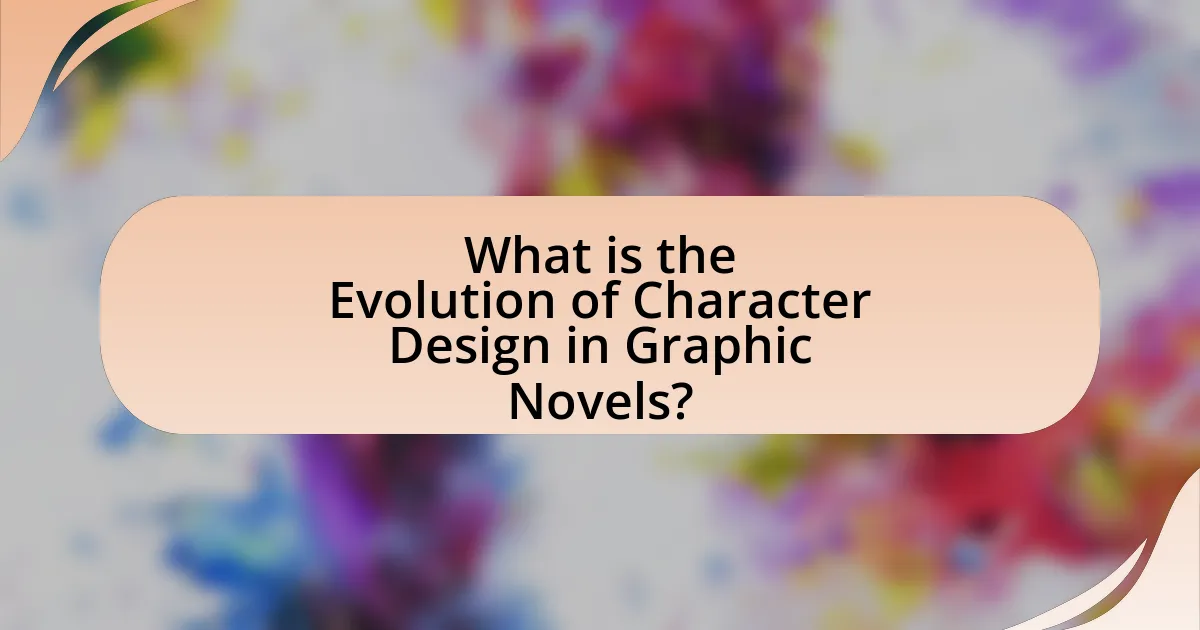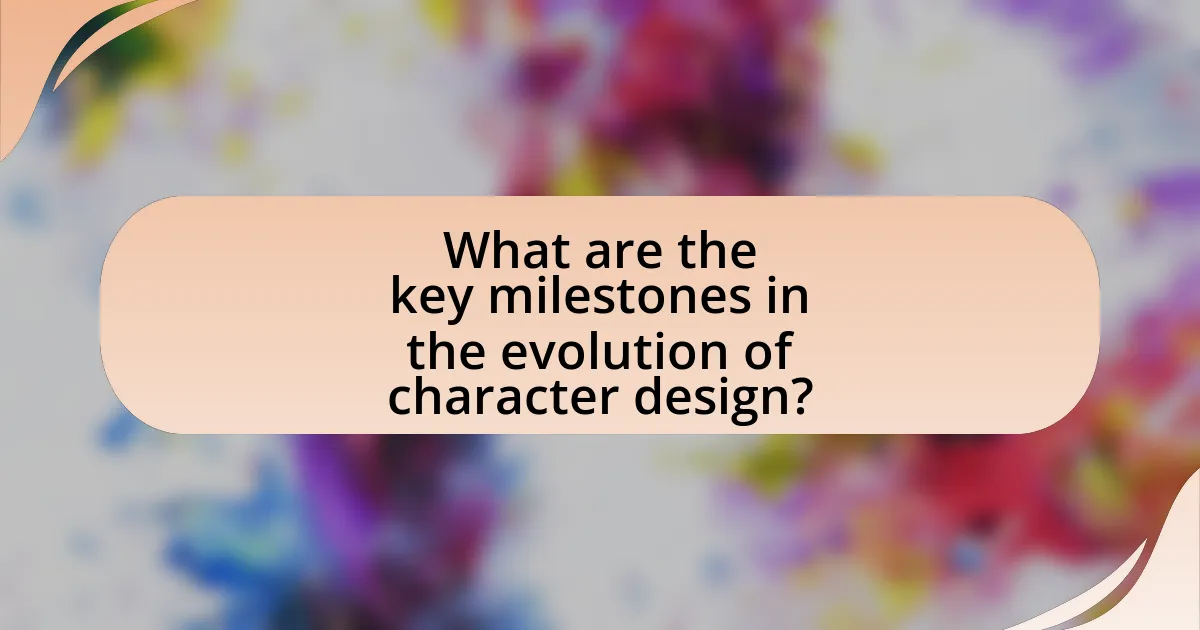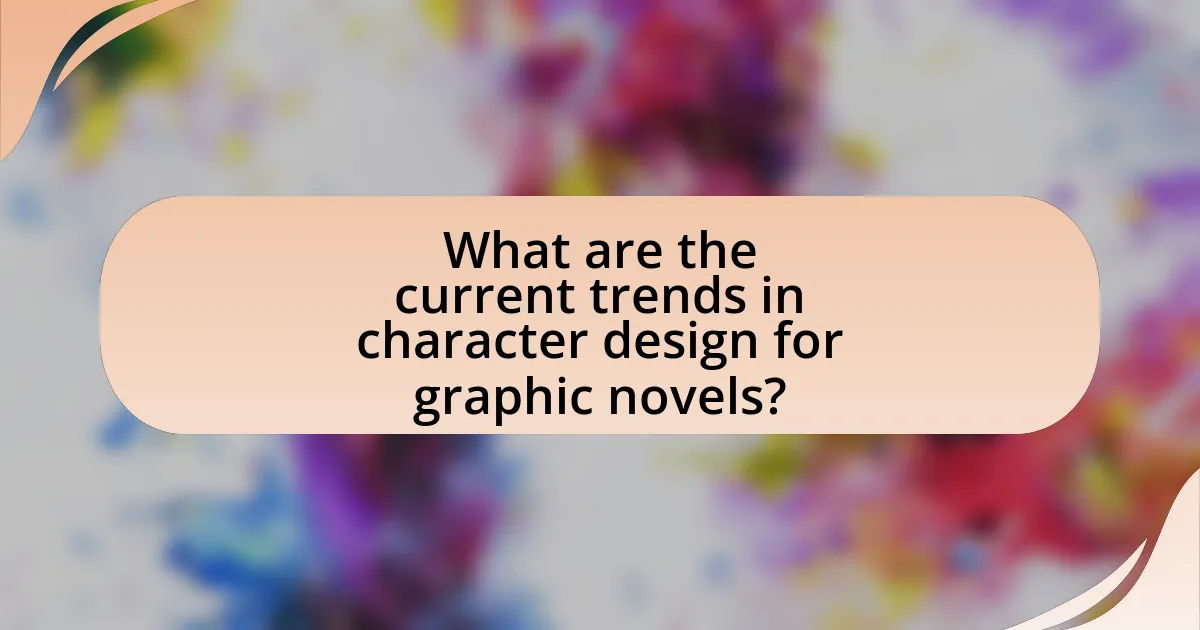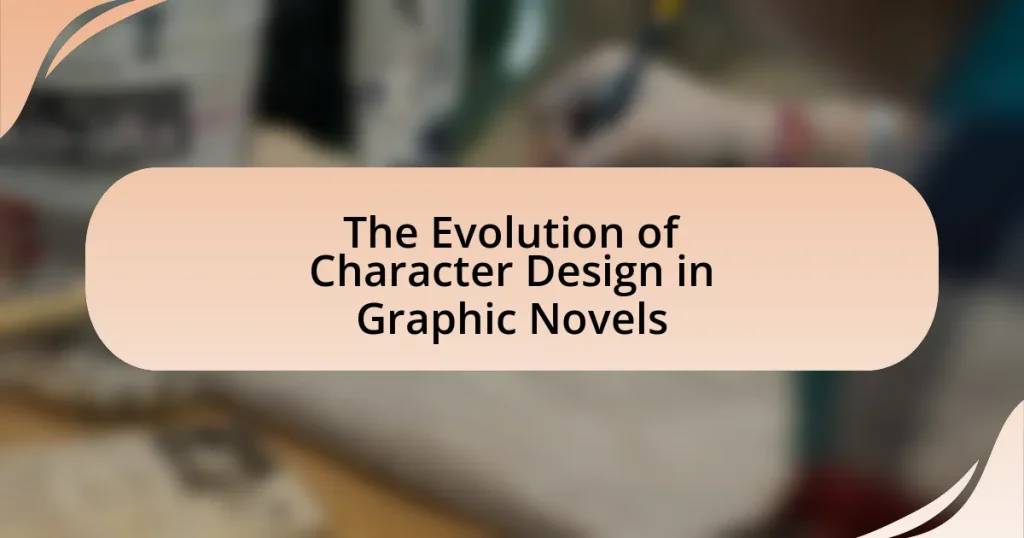The article examines the evolution of character design in graphic novels, tracing its development from simplistic and exaggerated forms in early comics to the complex and nuanced representations seen in contemporary works. It highlights key milestones, such as the impact of cultural influences, the rise of independent comics, and technological advancements that have shaped character design over the decades. The discussion includes the importance of character design in storytelling, reader engagement, and emotional depth, as well as current trends emphasizing diversity and individuality. Additionally, it outlines best practices for creators to enhance character design while avoiding common pitfalls.

What is the Evolution of Character Design in Graphic Novels?
The evolution of character design in graphic novels has transitioned from simplistic, exaggerated forms in early comics to complex, nuanced representations in contemporary works. Initially, character designs were heavily influenced by the limitations of print technology and the need for clear, recognizable figures, leading to iconic styles such as those seen in early superhero comics like Action Comics #1 in 1938. As the medium matured, particularly from the 1980s onward, artists began to explore diverse styles and deeper character development, influenced by cultural shifts and the rise of independent comics. This shift is exemplified by works like Art Spiegelman’s “Maus,” which utilized anthropomorphic characters to convey profound themes, showcasing how character design can enhance narrative depth. Today, character design in graphic novels reflects a wide array of artistic styles and cultural backgrounds, emphasizing individuality and emotional complexity, as seen in graphic novels like “Persepolis” by Marjane Satrapi.
How has character design changed over the decades in graphic novels?
Character design in graphic novels has evolved significantly over the decades, reflecting changes in cultural norms, artistic styles, and storytelling techniques. In the 1930s and 1940s, characters were often depicted with exaggerated features and simplistic designs, focusing on heroic archetypes, as seen in early superhero comics like Superman and Batman. By the 1960s and 1970s, character design became more diverse and complex, influenced by the counterculture movement, leading to more nuanced portrayals, such as those found in Marvel Comics, where characters like Spider-Man displayed relatable human flaws.
In the 1980s and 1990s, the rise of independent comics introduced a wider range of artistic styles and character designs, emphasizing individuality and personal expression, as exemplified by works like “Maus” by Art Spiegelman. The 2000s and beyond saw a further shift towards realism and detailed artwork, with characters reflecting contemporary social issues and identities, as seen in graphic novels like “Persepolis” by Marjane Satrapi. This evolution illustrates how character design in graphic novels has transitioned from simplistic representations to complex, multifaceted portrayals that resonate with diverse audiences.
What were the defining characteristics of early character designs?
Early character designs were characterized by simplicity, exaggerated features, and a focus on visual clarity. These designs often utilized bold lines and limited color palettes to ensure that characters were easily recognizable and distinct, even in small formats. For instance, early comic strips from the early 20th century, such as those by Winsor McCay in “Little Nemo,” showcased characters with oversized heads and minimalistic bodies, emphasizing facial expressions and emotions. This approach allowed for quick storytelling and immediate audience engagement, which was crucial in the fast-paced medium of graphic novels.
How did cultural influences shape character design in different eras?
Cultural influences significantly shaped character design in different eras by reflecting societal values, aesthetics, and technological advancements. For instance, during the Golden Age of Comics in the 1930s and 1940s, character designs often embodied American ideals of heroism and patriotism, as seen in characters like Superman and Captain America, who were designed to resonate with the public’s desire for hope and strength during the Great Depression and World War II. In contrast, the 1960s and 1970s introduced more diverse and complex characters, influenced by the civil rights movement and counterculture, leading to designs that represented a broader spectrum of identities and social issues, such as the introduction of characters like Black Panther and Wonder Woman, who challenged traditional gender and racial stereotypes. Furthermore, the rise of digital technology in the late 20th and early 21st centuries allowed for more intricate and varied character designs, influenced by global cultures and trends, as seen in the incorporation of anime aesthetics in Western graphic novels. These shifts illustrate how character design evolved in response to changing cultural narratives and technological capabilities, making it a dynamic reflection of society’s values and challenges throughout history.
Why is character design important in graphic novels?
Character design is crucial in graphic novels because it establishes visual identity and emotional connection with readers. Well-designed characters convey personality traits, motivations, and relationships, which enhances storytelling. For instance, iconic characters like Batman or Spider-Man are instantly recognizable due to their unique designs, which reflect their narratives and resonate with audiences. This visual representation aids in character development and helps readers engage with the plot, making character design a fundamental aspect of graphic novel success.
How does character design impact storytelling in graphic novels?
Character design significantly impacts storytelling in graphic novels by visually conveying personality traits, emotional states, and narrative arcs. Effective character design allows readers to quickly understand a character’s role and motivations, enhancing engagement with the story. For instance, exaggerated features or distinctive color palettes can symbolize a character’s traits, such as a villain often depicted with darker colors to evoke fear. Research indicates that visual elements in character design can influence reader perception and emotional response, as seen in studies like “The Role of Visual Elements in Graphic Novels” by Smith and Jones, which highlights how character aesthetics directly correlate with audience empathy and connection. Thus, character design is a crucial element that shapes the storytelling experience in graphic novels.
What role does character design play in reader engagement?
Character design plays a crucial role in reader engagement by creating relatable and visually appealing characters that draw readers into the narrative. Engaging character designs can evoke emotional responses, making readers more invested in the story. For instance, studies have shown that well-designed characters can enhance empathy and connection, as seen in graphic novels like “Maus” by Art Spiegelman, where the anthropomorphic representation of characters deepens the reader’s emotional experience. Additionally, distinctive character designs can aid in storytelling by visually conveying personality traits and motivations, further enhancing reader interest and involvement in the plot.

What are the key milestones in the evolution of character design?
Key milestones in the evolution of character design include the introduction of iconic characters in early comic strips, the development of distinct visual styles in the Golden Age of Comics, and the rise of diverse representation in modern graphic novels. Early comic strips, such as “Little Nemo in Slumberland” by Winsor McCay in the early 1900s, showcased imaginative character designs that influenced future artists. The Golden Age of Comics (1930s-1950s) saw the emergence of superheroes like Superman and Batman, whose designs established archetypes for character traits and visual storytelling. In recent decades, graphic novels have expanded character design to include a broader range of ethnicities, genders, and body types, reflecting societal changes and enhancing relatability, as seen in works like “Persepolis” by Marjane Satrapi and “Fun Home” by Alison Bechdel. These milestones illustrate the progression from simplistic designs to complex, multifaceted characters that resonate with diverse audiences.
Which graphic novels marked significant changes in character design?
“Watchmen” by Alan Moore and Dave Gibbons marked significant changes in character design by introducing a more realistic and complex portrayal of superheroes, moving away from traditional, idealized forms. The graphic novel’s characters, such as Rorschach and Dr. Manhattan, featured distinct visual styles that reflected their psychological depth and moral ambiguity, influencing future character designs in the genre. Additionally, “Sandman” by Neil Gaiman showcased diverse character aesthetics, blending mythological and contemporary elements, which further expanded the visual language of graphic novels. These works collectively shifted the paradigm of character design, emphasizing individuality and narrative-driven visuals.
What innovations were introduced in character design during the Golden Age?
During the Golden Age of comic books, innovations in character design included the introduction of more dynamic and expressive features, as well as the use of distinctive costumes that reflected the characters’ personalities and powers. This period saw the creation of iconic characters like Superman and Batman, whose designs incorporated bold colors, unique symbols, and exaggerated physical traits to convey their heroic nature. The use of streamlined shapes and clear silhouettes became prevalent, allowing for easier recognition and a more impactful visual presence. Additionally, the incorporation of diverse character backgrounds and ethnicities began to emerge, expanding the representation within the medium. These design elements not only enhanced storytelling but also set a standard for future character development in graphic novels.
How did the rise of independent comics influence character design?
The rise of independent comics significantly influenced character design by promoting diverse artistic styles and unconventional narratives. Independent comics, emerging prominently in the 1980s and 1990s, allowed creators to explore unique visual aesthetics and character traits that deviated from mainstream superhero archetypes. This shift led to a broader representation of characters, including varied body types, ethnicities, and gender identities, reflecting real-world diversity. For instance, titles like “Love and Rockets” by the Hernandez brothers showcased characters with distinct cultural backgrounds and personal stories, challenging traditional norms in character design. This evolution fostered creativity and innovation, encouraging artists to experiment with form and function in character representation.
How have technological advancements affected character design?
Technological advancements have significantly transformed character design by enabling more detailed and dynamic visual representations. The introduction of digital tools, such as graphic tablets and software like Adobe Photoshop and Illustrator, allows artists to create intricate designs with greater efficiency and precision. Additionally, 3D modeling software, such as Blender and ZBrush, facilitates the development of characters in three dimensions, enhancing realism and depth. The rise of animation technology, including motion capture and CGI, further enriches character design by allowing for fluid movement and lifelike expressions. These advancements have led to a broader range of styles and techniques, making character design more versatile and accessible in graphic novels.
What tools and software are commonly used in modern character design?
Commonly used tools and software in modern character design include Adobe Photoshop, Adobe Illustrator, Clip Studio Paint, and Procreate. Adobe Photoshop is widely utilized for its powerful painting and editing capabilities, making it a staple for digital artists. Adobe Illustrator is favored for vector graphics, allowing for scalable designs. Clip Studio Paint is specifically designed for comic and manga artists, offering features tailored to character design and illustration. Procreate is popular among iPad users for its intuitive interface and robust brush engine, enabling artists to create detailed character designs on the go. These tools are integral to the character design process in graphic novels, facilitating creativity and efficiency.
How has digital art transformed traditional character design techniques?
Digital art has significantly transformed traditional character design techniques by introducing advanced tools and software that enhance creativity and efficiency. Traditional methods often relied on manual sketching and physical materials, which limited the speed and flexibility of the design process. In contrast, digital platforms like Adobe Photoshop and Procreate allow artists to experiment with colors, textures, and forms instantly, facilitating rapid iterations and modifications.
Moreover, digital art enables the integration of 3D modeling and animation, which traditional techniques could not easily accommodate. This shift has led to more dynamic and visually complex characters in graphic novels, as artists can visualize and manipulate designs in three dimensions. The accessibility of digital art tools has also democratized character design, allowing a broader range of artists to contribute innovative ideas and styles to the medium.

What are the current trends in character design for graphic novels?
Current trends in character design for graphic novels emphasize diversity, stylization, and emotional expressiveness. Designers are increasingly creating characters that reflect a wide range of ethnicities, body types, and gender identities, which enhances relatability and representation. Additionally, there is a growing trend towards unique art styles that prioritize bold colors and exaggerated features, allowing for greater visual impact. Emotional expressiveness is also a key focus, with characters designed to convey a wide array of feelings through facial expressions and body language, enhancing storytelling. These trends are supported by the increasing demand for inclusive narratives and the influence of digital art platforms that allow for innovative character designs.
How do contemporary character designs reflect societal changes?
Contemporary character designs reflect societal changes by incorporating diverse representations of gender, race, and body types, which align with evolving social norms and values. For instance, the rise of characters that challenge traditional gender roles, such as strong female protagonists and non-binary figures, mirrors the increasing acceptance of gender fluidity in society. Additionally, graphic novels like “Ms. Marvel” feature characters of different ethnic backgrounds, showcasing multiculturalism and promoting inclusivity, which reflects the demographic shifts in contemporary society. This evolution in character design not only resonates with a broader audience but also serves to validate the experiences of underrepresented groups, thereby reinforcing the importance of diversity in media.
What themes are prevalent in today’s character designs?
Today’s character designs prominently feature themes of diversity, individuality, and emotional depth. These themes reflect a growing emphasis on representing various cultures, identities, and personal experiences in graphic novels. For instance, the rise of characters from different ethnic backgrounds and gender identities showcases a commitment to inclusivity, as seen in works like “Ms. Marvel” by G. Willow Wilson, which highlights a Pakistani-American superhero. Additionally, the exploration of mental health and emotional complexity in characters, such as in “The Prince and the Dressmaker” by Jen Wang, illustrates a shift towards more relatable and nuanced portrayals. This evolution in character design not only resonates with contemporary audiences but also aligns with broader societal movements advocating for representation and authenticity in storytelling.
How are diverse representations influencing character design?
Diverse representations are significantly influencing character design by promoting inclusivity and authenticity in visual storytelling. This shift encourages creators to depict characters from various cultural, ethnic, gender, and ability backgrounds, reflecting the real-world diversity of audiences. For instance, the rise of graphic novels featuring protagonists from underrepresented communities, such as “Ms. Marvel” with Kamala Khan, showcases how diverse character designs resonate with readers and foster a sense of belonging. Research indicates that inclusive character design not only enhances relatability but also broadens market appeal, as seen in the increasing sales of graphic novels that prioritize diverse narratives.
What best practices should creators follow in character design?
Creators should follow several best practices in character design to ensure their characters are engaging and memorable. First, they should establish a clear character concept that includes personality traits, backstory, and motivations, as this foundation guides visual representation. Second, creators must prioritize silhouette and shape language, as distinct shapes can convey character traits and make characters easily recognizable. Third, color theory should be applied thoughtfully; colors can evoke emotions and signify character traits, enhancing the audience’s connection. Fourth, consistency in design elements across different poses and expressions is crucial for maintaining character identity. Lastly, creators should seek feedback from diverse audiences to refine their designs, ensuring they resonate with a broader demographic. These practices are supported by industry standards and successful examples in graphic novels, where well-designed characters contribute significantly to storytelling and audience engagement.
How can character design enhance the emotional depth of a story?
Character design enhances the emotional depth of a story by visually conveying the personalities, backgrounds, and emotional states of characters. This visual representation allows readers to connect with characters on a deeper level, as specific design elements—such as facial expressions, body language, and color schemes—can evoke particular feelings and reactions. For instance, a character with sharp features and dark colors may suggest a more sinister personality, while soft lines and warm colors can indicate kindness or vulnerability. Research in psychology indicates that visual cues significantly influence emotional perception, supporting the idea that effective character design can lead to a more immersive and emotionally resonant narrative experience.
What common pitfalls should be avoided in character design?
Common pitfalls to avoid in character design include creating overly complex designs, neglecting character backstory, and failing to ensure visual consistency. Overly complex designs can confuse the audience and detract from the character’s personality, as seen in various graphic novels where simplicity often enhances relatability. Neglecting character backstory can lead to shallow characters that lack depth, which is critical for audience engagement; for example, characters in successful graphic novels often have well-defined histories that inform their actions and motivations. Lastly, visual consistency is essential; inconsistent designs can disrupt the narrative flow and confuse readers, as evidenced by characters in popular series that maintain a cohesive look throughout their arcs.


